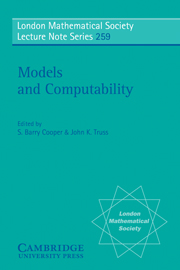Book contents
- Frontmatter
- Contents
- Preface
- Continuous Functionals of Dependent and Transfinite Types
- Degree-Theoretic Aspects of Computably Enumerable Reals
- Simplicity and Independence for Pseudo-Algebraically Closed Fields
- Clockwork or Turing U/universe? - Remarks on Causal Determinism and Computability
- A Techniques Oriented Survey of Bounded Queries
- Relative Categoricity in Abelian Groups
- Computability and Complexity Revisited
- Effective Model Theory: The Number of Models and Their Complexity
- A Survey on Canonical Bases in Simple Theories
- True Approximations and Models of Arithmetic
- On the Topological Stability Conjecture
- A Mahlo-Universe of Effective Domains with Totality
- Logic and Decision Making
- The Sheaf of Locally Definable Scalars over a Ring
- Human Styles of Quantificational Reasoning
- Recursion Theoretic Memories 1954–1978
- Fields Definable in Simple Groups
- A Combinatory Algebra for Sequential Functionals of Finite Type
- Model Theory of Analytic and Smooth Functions
Computability and Complexity Revisited
Published online by Cambridge University Press: 17 May 2010
- Frontmatter
- Contents
- Preface
- Continuous Functionals of Dependent and Transfinite Types
- Degree-Theoretic Aspects of Computably Enumerable Reals
- Simplicity and Independence for Pseudo-Algebraically Closed Fields
- Clockwork or Turing U/universe? - Remarks on Causal Determinism and Computability
- A Techniques Oriented Survey of Bounded Queries
- Relative Categoricity in Abelian Groups
- Computability and Complexity Revisited
- Effective Model Theory: The Number of Models and Their Complexity
- A Survey on Canonical Bases in Simple Theories
- True Approximations and Models of Arithmetic
- On the Topological Stability Conjecture
- A Mahlo-Universe of Effective Domains with Totality
- Logic and Decision Making
- The Sheaf of Locally Definable Scalars over a Ring
- Human Styles of Quantificational Reasoning
- Recursion Theoretic Memories 1954–1978
- Fields Definable in Simple Groups
- A Combinatory Algebra for Sequential Functionals of Finite Type
- Model Theory of Analytic and Smooth Functions
Summary
Abstract
A programming approach to computability and complexity theory yields proofs of central results that are sometimes more natural than the classical ones; and some new results as well. This paper contains some high points from the recent book, emphasising what is different or novel with respect to more traditional treatments. Topics include:
Kleene's s-m-n theorem applied to compiling and compiler generation.
Proof that constant time factors do matter, for on a natural computation model, problems solvable in linear time have a proper hierarchy, ordered by coefficient values.
Characterisations in programming terms of the classes LOGSPACE and PTIME. These are intrinsic: without externally imposed space or time computation bounds.
Kleene's Second Recursion theorem: an efficient implementation.
Results on which problems possess optimal algorithms, including: Levin's Search theorem (first time in book form) and Blum's Speedup.
Boolean program problems complete for ptime, nptime, pspace.
Introduction
The recent book differs didactically and foundationally from traditional treatments of computability and complexity theory. Its didactic aim is to teach the main theorems of these fields to computer scientists. Its approach is to exploit as much as possible the readers' programming intuitions, and to motivate subjects by their relevance to programming concepts. Foundationally it differs by using, instead of the natural numbers ℕ, binary trees as data (as in the programming language Lisp). Consequently programs are data, avoiding the usual complexities and inefficiencies of encoding program syntax as Gödel numbers.
- Type
- Chapter
- Information
- Models and Computability , pp. 169 - 192Publisher: Cambridge University PressPrint publication year: 1999
- 2
- Cited by

